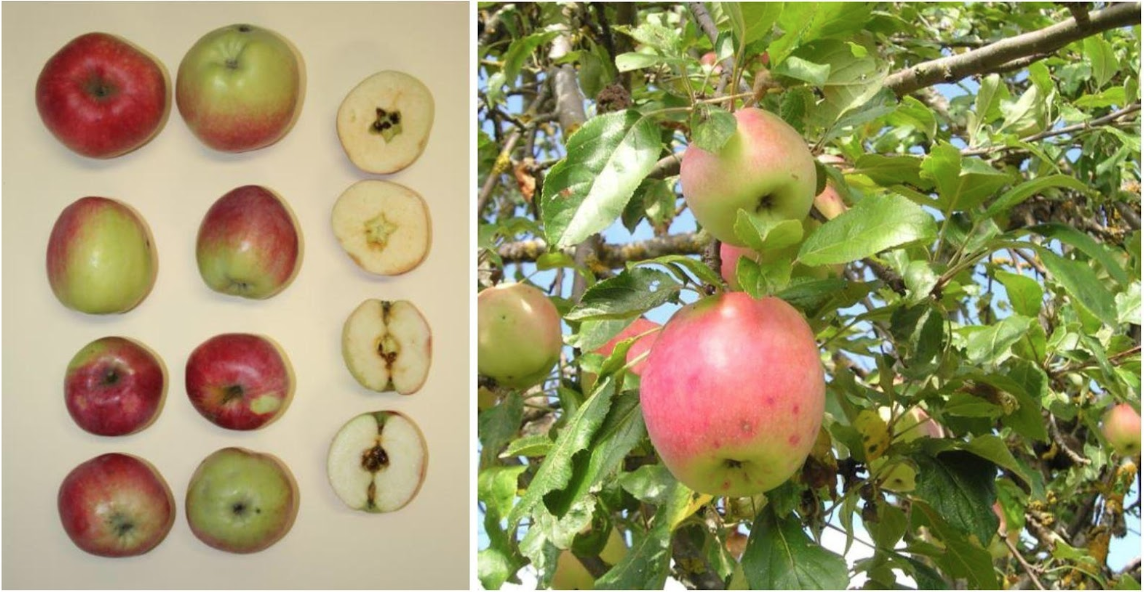Crop: Malus domestica Borkh (Apple)
The name ‘Mela a Sonagli’, literally ‘rattling apple’, is related to a peculiar feature of the mature fruits produced by this landrace: at maturity seeds detach from the core; When the fruit is shaken, it is possible to hear the seeds themselves moving inside the mature fruits.
The tree is characterised by high vigour and upright tree habit. Flowers are grouped in corymbs carrying six flowers each; on average the corolla is 44mm and petals are elliptic-rounded shaped. Before anthesis, flowers are light pink. On average leaves are 99 mm long and 52 mm wide.
Fruits are medium size (circa 160 g), characterised by and ellipsoidal shape. The skin is smooth and ground-colour is greenish/yellow while the over-colour is red. Fruit surface russetted is generally low. The pulp is white and the fruit texture intermediate.
Flowering occurs in April and the harvest is generally carried out in September.
Cultivation System: conventional conditions.
Geographical Information
Country: Italy
‘Mela a Sonagli’ was cultivated within the Umbra valley (central Italy), especially under the municipalities of Foligno and Spoleto (Province of Perugia, Italy). However, various individuals were also found within the territories belonging to the municipalities of Massa Martana, Gualdo Cattaneo, Cascia (Province of Perugia) and in Acquasparta (Province of Terni).
Farmer(s) description:
Currently, few plants are conserved on-farm. Typically, plants are conserved within different farms and small private orchards only for family consumption. It is estimated that circa ten farmers/gardeners are still conserving 1-2 individual plants.
Propagation system: Clonal
Multiplication procedures and consequences on landrace diversity:As other apple varieties, this landrace is propagated by grafting onto rootstocks. The propagation activity is mainly carried out by the Foundation named ‘Archeologia Arborea’ (San Lorenzo – Lerchi, Perugia, Italy). Currently, the vegetative propagation of this landrace was carried out in order to produce very few individuals using both Malling 25 rootstocks (very vigorous rootstock) or wild rootstocks.
The use of grafting starting from very few individuals causes reduction of the within population genetic diversity. Anyhow, the vigour of the grafted plants together with their adaptability to different soils can be managed through selection of proper rootstocks.
Management plan existence:The landrace management relies completely on farming activities in the area. Currently, no technical or scientific support is given.
Added Values
Currently, no local or national market exists as the production of ‘Mela a Sonagli’ is carried out by few farmers/gardners, conserving 1-2 individuals, for their family consumption.
Others (e.g. commercial/geographical brands or special traits):In 2014 ‘Mela a Sonagli’ was included into the regional register of landraces (Umbria Region, Italy) implementing the Umbria Region Law concerning the protection of local genetic resources (n. 25, 2001).
‘Mela a Sonagli’ was rescued within a project funded by the Province of Perugia through a plan of valorisation of agro-biodiversity (within the the EU’s Rural Development Plan 2000-2006). Within this framework the University of Perugia gave technical and scientific support.
Currently, ‘Mela a Sonagli’ is conserved in four different ex situ collections: i) Within the fruit tree collection of 3A-PTA in Todi (Perugia Italy) and ii) in vitro at the germplasm bank held by the same institution; iiI) within the tree collection belonging to ‘Fondazione per l’Istruzione Agraria’ in Deruta (Perugia, Italy) and iv) it is also conserved in the tree collection belonging to the Foundation named ‘Archeologia Arborea’ (San Lorenzo – Lerchi, Perugia, Italy).
Provisions set by the local organisations aimed at characterising and saving the landrace. However, at present, further activities are needed to enhance on-farm conservation and to increase the use of such resource.
Uncertain. To have access to the resource ‘Regione Umbria’ (http://www.regione.umbria.it/agricoltura) or
‘3A-PTA’ (http://www.parco3a.org/pagine/contatti-004) should be contacted.
Most of updates have been retrieved from 3A-PTA website (http://biodiversita.umbria.parco3a.org/schede/mela-a-sonagli).
Information were also communicated by Dr I. Dalla Ragione (Fondazione Archeologia Arborea).
ND.
